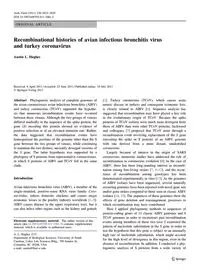
2011 Recombinational histories of avian infectious bronchitis virus and turkey coronavirus PDF
Preview 2011 Recombinational histories of avian infectious bronchitis virus and turkey coronavirus
ORIGINAL ARTICLE Recombinational histories of avian infectious bronchitis virus and turkey coronavirus Austin L. Hughes Received: 8 April 2011 / Accepted: 25 June 2011 / Published online: 10 July 2011 � Springer-Verlag 2011 Abstract Phylogenetic analysis of complete genomes of the avian coronaviruses avian infectious bronchitis (AIBV) and turkey coronavirus (TCoV) supported the hypothe- sis that numerous recombination events have occurred between these viruses. Although the two groups of viruses differed markedly in the sequence of the spike protein, the gene (S) encoding this protein showed no evidence of positive selection or of an elevated mutation rate. Rather, the data suggested that recombination events have homogenized the portions of the genome other than the S gene between the two groups of viruses, while continuing to maintain the two distinct, anciently diverged versions of the S gene. The latter hypothesis was supported by a phylogeny of S proteins from representative coronaviruses, in which S proteins of AIBV and TCoV fell in the same clade. Introduction Avian infectious bronchitis virus (AIBV), a member of the single-stranded, positive-sense RNA virus family Coro- naviridae, infects domestic chickens and causes major economic losses to the poultry industry worldwide [1–5]. AIBV causes disease in the upper respiratory tract, but it can also infect other organs such as the kidney and gonads [2]. Turkey coronavirus (TCoV), which causes acute enteric disease in turkeys and consequent economic loss, is closely related to AIBV [6]. Sequence analysis has suggested that recombination may have played a key role in the evolutionary origin of TCoV. Because the spike proteins of TCoV isolates were much more divergent from those of AIBV than were other TCoV proteins, Jackwood and colleagues [7] proposed that TCoV arose through a recombination event involving replacement of the S gene (encoding the spike or S protein) of an AIBV genome with one derived from a more distant, unidentified coronavirus. Largely because of interest in the origin of SARS coronavirus, numerous studies have addressed the role of recombination in coronavirus evolution [8]. In the case of AIBV, there has been long-standing interest in recombi- nation among free-living strains [7, 9–12], and the occur- rence of recombination among genotypes has been demonstrated experimentally in vitro [13]. As the genomes of AIBV isolates have been sequenced, several naturally occurring genomes have been reported with novel gene sets and/or gene orders compared to those seen in classic AIBV isolates [14, 15]. The sequences of these genomes show the effects of gene deletion and rearrangement, processes to which recombination may have contributed. Here I applied phylogenetic methods to sequences of protein-coding genes of 11 classic AIBV genomes and 6 TCoV genomes in order to reconstruct past recombination events among members of these two taxa. I examined the pattern of nucleotide substitution in the S gene in order to test the hypothesis that this gene is subject to an unusually high rate of nucleotide substitution, which might account for the high level of divergence in this region, even in the absence of recombination. In addition, I conducted a phy- logenetic analysis of S proteins from a wide variety of Electronic supplementary material The online version of this article (doi:10.1007/s00705-011-1061-5) contains supplementary material, which is available to authorized users. A. L. Hughes (&) Department of Biological Sciences, University of South Carolina, Coker Life Sciences Bldg., 700 Sumter St, Columbia, SC 29208, USA e-mail:
